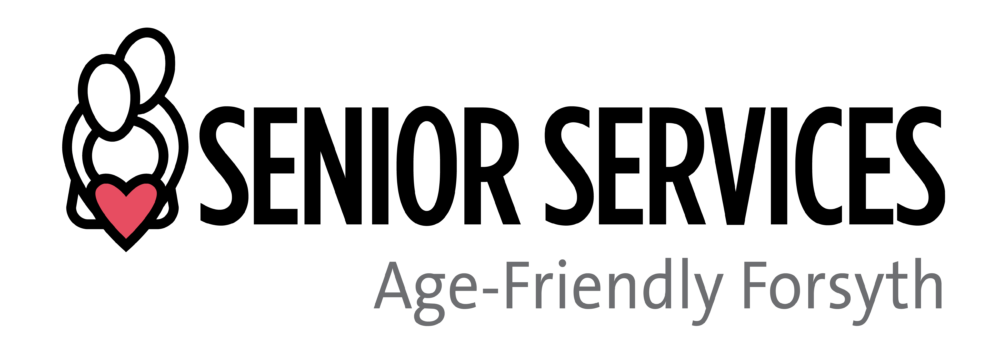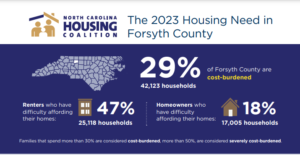The following are general resources.
Senior Services Directory
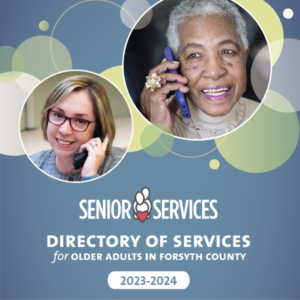
The Directory of Services is here! This resource book, published regularly by the Senior Services Help Line, includes contact information for organizations, services, health providers, and more to help older adults, caregivers, and anyone concerned about the well-being of seniors find and access the resources and information they need to continue to live as healthily, independently, and purposefully as possible.
For the most up-to-date Directory of Resources compiled by Senior Services, please CLICK HERE.
Otherwise, download the print-version of the 2023-2024 Directory of Services for Older Adults in Forsyth County here: CLICK TO DOWNLOAD PRINT-VERSION HERE
AARP Livability Index
 The link below will direct you to an overview description of the Forsyth County population by race, ethnicity and age as well as other indicators such as the percentage living in poverty. The report also includes other metrics tied to Housing (such as the availability of multi-family housing), Neighborhoods (such as access to parks), Transportation (such as household transportation costs), Environment (such as drinking water quality) Health (such as obesity prevalence) and Engagement (such as voting rate).
The link below will direct you to an overview description of the Forsyth County population by race, ethnicity and age as well as other indicators such as the percentage living in poverty. The report also includes other metrics tied to Housing (such as the availability of multi-family housing), Neighborhoods (such as access to parks), Transportation (such as household transportation costs), Environment (such as drinking water quality) Health (such as obesity prevalence) and Engagement (such as voting rate).
The report was prepared by the AARP Public Policy Institute which also provides an Overall Livability Index Score for Forsyth County. The score rates the overall livability of the county on a scale from 0 to 100 and is based upon the average scores of seven categories, five of which are identified above. Forsyth County’s Livability Index Score is 50, which is in the top half of communities in the U.S.
Please take a look at the information provided and consider how this information can support your planning to meet the needs of our aging population.
The following are snapshots of the demographics of Forsyth County residents.
Age My Way NC
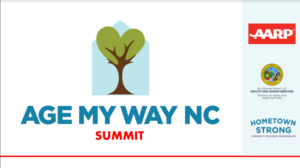
The Age-Friendly Network is affiliate of World Health Organization Global Network of Age-Friendly Cities and Communities Program. It was established to connect cities, communities, and organizations with a vision of making each community a great place where people can grow up and grow old. This program targets environmental, social, and economic factors.
In 2022, Age My Way /AARP and the North Carolina Department of Health and Human Services collaborated on conducting this survey to identify priorities for making North Carolina communities great places for all ages. 3,306 individuals 45 or more years of age across the state were surveyed to identify priorities. Highlights include:
- People want to stay in their communities and not relocate.
- People want to age in their own homes.
- Individuals worry about when they won’t be able to drive.
- People worry about becoming socially isolated.
- Employment for older and disabled adults is important issue that need to be addressed moving forward.
The link of the specific 2022 Age My Way North Carolina Survey results may be found using this link: Age My Way North Carolina
The following are resources related to housing.
The Future of Headship and Homeownership
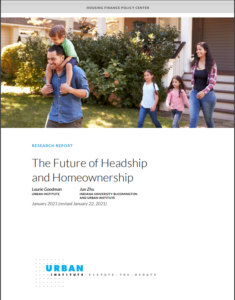
The information below summarizes the report’s findings:
Homeownership is a critical wealth-building tool, but not everyone has the same opportunities to become a homeowner. To create a more equitable and sustainable housing landscape, policymakers, thought leaders, and changemakers need to understand the trajectory of the homeownership rate—where it has been, where it is going, who it has benefitted, and who it has left behind.
To better understand this trajectory, we look at household formation and homeownership in the US over time, showing how a combination of economic cycles and public policies have widened racial homeownership gaps. We also project the future headship rate (the share of adults who are the heads of households) and the homeownership rate (the share of household heads who own their homes) through 2040.
Our analysis reveals several key findings:
- Household growth will be weak over the next two decades. Household growth averaged 12.4 million per decade from 1990-2010, 7.3 million from 2010-2020 and, we project 8.5 million from 2020-2030 and 7.6 million from 2030-2040. This decline is the result of slowing US population growth and lower headship rates for most age groups.
- All net household growth will be from households of color. Between 2020 and 2040, there will be 16.1 million net new households. Hispanic households will grow by 8.6 million, households of other races (mostly Asian households) will grow by 4.8 million, and Black households will grow by 3.4 million. White households will decline by 0.6 million.
- Almost all net household growth will be from senior households. Of the 16.1 million net new households formed between 2020 and 2040, 13.8 million will be headed by someone over 65.
- The homeownership rate will continue to fall for every age group. People who were 25 to 44 years old in 2010 are the most affected age group, as the Great Financial Crisis hindered their ability to become or remain owners. The aging of the US population will cushion the drop in the overall homeownership rate because older households have higher homeownership rates. We project the overall homeownership rate will fall from 65 percent in 2020 to 62 percent by 2040.
- The decline in the homeownership rate will be particularly pronounced for Black households headed by 45-to 74-year-olds. If current policies stay the same, the Black homeownership rate will fall well below the rate of previous generations at the same age and result in an unprecedented number of Black renters over 65; we project elderly Black renters will more than double from 1.3 million in 2020 to 2.6 million in 2040.
- Net growth in the number of homeowners from 2020 to 2040 will be entirely among people of color, especially Hispanic homeowners. Between 2020 and 2040, there will be 6.9 million net new homeowner households, a 9 percent increase. Hispanic homeowners will grow by 4.8 million, homeowners of other races (mostly Asian homeowners) will grow by 2.7 million, and Black homeowners will grow by 1.2 million. The total number of white homeowners will decline by 1.8 million.
- Renter growth will be more than twice the pace of homeowner growth from 2020 to 2040. Between 2020 and 2040, there will be 9.3 million net new renter households, a 21 percent increase. Hispanic renters will grow by 3.8 million, Black renters by 2.2 million, renters of other unspecified races (including Asian renters) by 2.1 million, and white renters by 1.2 million.
These findings have important implications for policies and practices:
- To support the large number of senior households, we need to urgently focus on developing and implementing policies that address their specific needs.
- To prepare for the surge in renters and coming demographic changes, we need to increase the supply of affordable homes and better tailor these homes to the needs of future owners and renters through more flexible zoning and land use regulations.
- To decrease the enormous racial homeownership gap, we need to take concerted action to:
-
- improve and expand financial education and homeownership preparation and increase the visibility, access, and types of down payment assistance programs;
- re-examine how we qualify borrowers for mortgages and revamp the process to more precisely assess creditworthiness; and
- implement programs that sustain homeownership for borrowers with less wealth, especially people of color.
NC Housing Coalition: The 2023 Housing Need in Forsyth County
The NC Housing Coalition’s County Profiles provide a snapshot of housing needs for each of North Carolina’s 100 counties. They provide data on cost-burdened households paying at least 30% of their income for housing, a comparison of what different jobs pay and changes in home prices, foreclosures, and rental options in our communities.
The County Profiles are designed to be used by advocates in their communities and with their local and state elected officials as an education tool around the housing issues we all face in our cities and towns. The data is gathered from a variety of sources including:
- The most recent 2017-2021 American Community Survey 5-Year Estimates from the US Census Bureau;
- The most recent 2021 Occupational Employment Statistics data from the Bureau of Labor Statistics;
- FY23 Fair Market Rents from the US Department of Housing and Urban Development;
- IFY 2022 Median Family Income Documentation System from the US Department of Housing and Urban Development; and
- Civil Issue Filings/Order Results FY21-22 from the NC Judicial Branch
Key Findings for Forsyth County:
- 29% of Forsyth County is cost-burdened based upon housing expenses. That means they spend more than 30% of their income on housing.
- 47% of Renters have difficulty affording their homes
- 18% of Homeowners have difficulty affording their homes
National Low income Housing Coalition
- Dedicated to achieving racially and socially equitable public policy that ensures people with the lowest incomes have quality homes that are accessible and affordable in communities of their choice
- Great at explaining the nuances of HUD’s Section 202: Housing for the Elderly and tracks investments being made. FYI- 202 Population: People over 62 with very low incomes: below 50% of area median income
- In FY20 HUD appropriation bill, Congress included $90 million in the 202 account for the construction and operation of new Section 202 homes. Between FY2012 and FY2016 Congress provided no money for new Section 202 homes
North Carolina Housing Finance Agency
The NCHFA is a self-supporting public agency that provides safe, affordable housing opportunities to enhance the quality of life of North Carolinians.
- Since its creation by the General Assembly, the Agency has financed more than 298,860 affordable homes and apartments, totaling $29.16 billion.
- The Agency provides financing through the sale of tax-exempt bonds and management of federal tax credit programs, the federal HOME Program, the state and national Housing Trust Funds, and other programs.
Housing Authority of Winston-Salem
- The purpose of the Authority is to provide safe and sanitary dwelling accommodations for persons of low income.
- Manages the process of applying for Public Housing or Housing Choice Voucher.
Winston-Salem Affordable Housing Coalition
- The purpose of the Affordable Housing Coalition shall be to identify and recommend strategies that:
- Expand affordable opportunities
- Engage supporters of and advocates for affordable housing
- Coordinate and secure sustainable resources for affordable housing
- Advise the Winston-Salem City Council on the use of City funds to support affordable housing development
